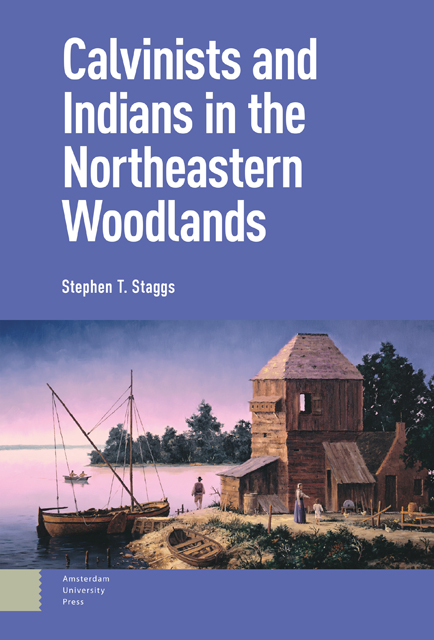Book contents
- Frontmatter
- Contents
- Acknowledgements
- Abbreviations
- List of Figures
- Notes on Usage
- Introduction
- 1 “Gentiles by Nature,” 1566–1626
- 2 “So That the Fullness of the Gentiles Might Gradually Come In,” 1627–1642
- 3 “A Church and Community among the Christians and the Blind Gentiles,” 1642–1652
- 4 “We, with God’s Help, Hope to Bring the Barbarous Tribes to Devotion,” 1652–1660
- 5 “Who Gave Jacob for a Spoil and Israel to the Robbers?” 1660–1664
- 6 “A Gentile Woman, Karanondo, … Now Called Lidia,” 1664–1750
- Conclusion
- Appendix A Dutch References to Indians: 1609–1664
- Appendix B Indian Baptisms, Professions of Faith, and Marriages in the Dutch Reformed Churches of New York: 1690–1750
- List of Archival Sources
- Bibliography
- Index
- Frontmatter
- Contents
- Acknowledgements
- Abbreviations
- List of Figures
- Notes on Usage
- Introduction
- 1 “Gentiles by Nature,” 1566–1626
- 2 “So That the Fullness of the Gentiles Might Gradually Come In,” 1627–1642
- 3 “A Church and Community among the Christians and the Blind Gentiles,” 1642–1652
- 4 “We, with God’s Help, Hope to Bring the Barbarous Tribes to Devotion,” 1652–1660
- 5 “Who Gave Jacob for a Spoil and Israel to the Robbers?” 1660–1664
- 6 “A Gentile Woman, Karanondo, … Now Called Lidia,” 1664–1750
- Conclusion
- Appendix A Dutch References to Indians: 1609–1664
- Appendix B Indian Baptisms, Professions of Faith, and Marriages in the Dutch Reformed Churches of New York: 1690–1750
- List of Archival Sources
- Bibliography
- Index
Summary
This work analyzes the impact of the Dutch Reformation upon the cross-cultural relations between the Indians and Europeans living in the early modern Northeastern Woodlands.These interactions took place between several different Indian, African, and European peoples. Counted among the Native North Americans were autonomous Muhhekunneuw (Mahican) and Lunaapeew (Lenape) communities along the Muhheakantuck (Hudson River) and Lenapewihittuck (Delaware River); Narragansetts, Mohegan-Pequots, and other groups living in southern New England and Suanhacky (Long Island); and the Susquehannock and Haudenosaunee (Iroquois) peoples of the interior. Among the Africans were free and enslaved Creole, Wolof, Mandika, Bamana (Bambara), Ausa (Hausa), Akan, Aja, Yoruba, Igbo, Bisi Kongo (Kongo), Ambundu (Mbundu), Ovimbundu, and Malagasy peoples while the Europeans included Walloon, Dutch, English, Scottish, Irish, Huguenot, Jewish, German, Swedish, Italian, and Croat peoples who occupied settlements along the Lenapewihittuck, Muhheakantuck, and Kwenitegw (Connecticut River).
The Muhhekunneuw were Eastern Algonquian-speaking peoples who occupied lands on both sides of the Muhheakantuck from Papscanee Island south to about northern Dutchess County, and from the eastern edge of the Catskill Mountains in the west to the Housatonic Valley and the Sankhannek (Roeliff Jansen Kill) in the east.The Lunaapeew were linguistically and culturally similar groups that occupied the Lenapewihittuck river valley and certain adjacent areas at the beginning of the seventeenth century. The Lunaapeew who spoke Munsee inhabited the northern part of Lenapehoking (homelands of the Lenape), which included what is now northern New Jersey and southeastern New York. These Munsee-speaking bands included the Navesinks, Raritans, Hackensacks, Tappans, Minisinks, Esopus, Wappingers Kichtawanks, Sinsinks, Rechgawawanks, and Wiechquaeskecks. As they migrated west in the 1700s, many of these Lunaapeew came to be known as either Delawares or Munsees.The Lunaapeew groups who spoke Unami occupied the southern part of Lenapehoking, which included present-day southern New Jersey and a small portion of eastern Pennsylvania and northeastern Delaware.
At the time of earliest contact with Europeans in the sixteenth and early seventeenth centuries, the Indians of southern New England and Suanhacky shared a single cultural pattern. According to Bert Salwen, they “all spoke closely related Algonquian languages, obtained their food by combining maize-beans-squash horticulture with the collecting of land and sea fauna and wild plants, and engaged in very similar social, political, and religious practices centered on the village as the basic social unit.”
- Type
- Chapter
- Information
- Calvinists and Indians in the Northeastern Woodlands , pp. 17 - 26Publisher: Amsterdam University PressPrint publication year: 2023



